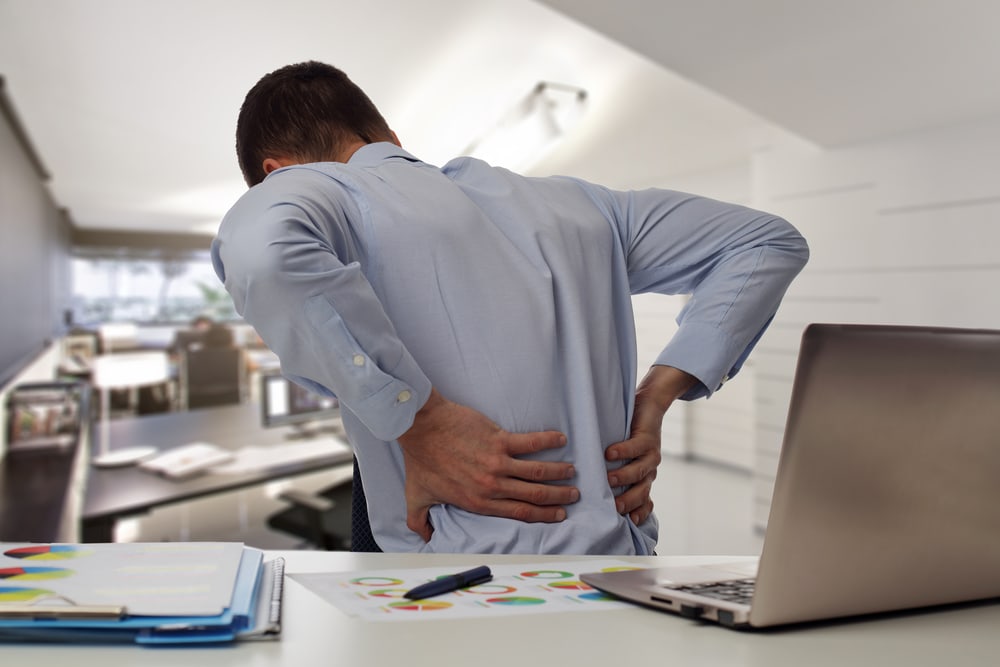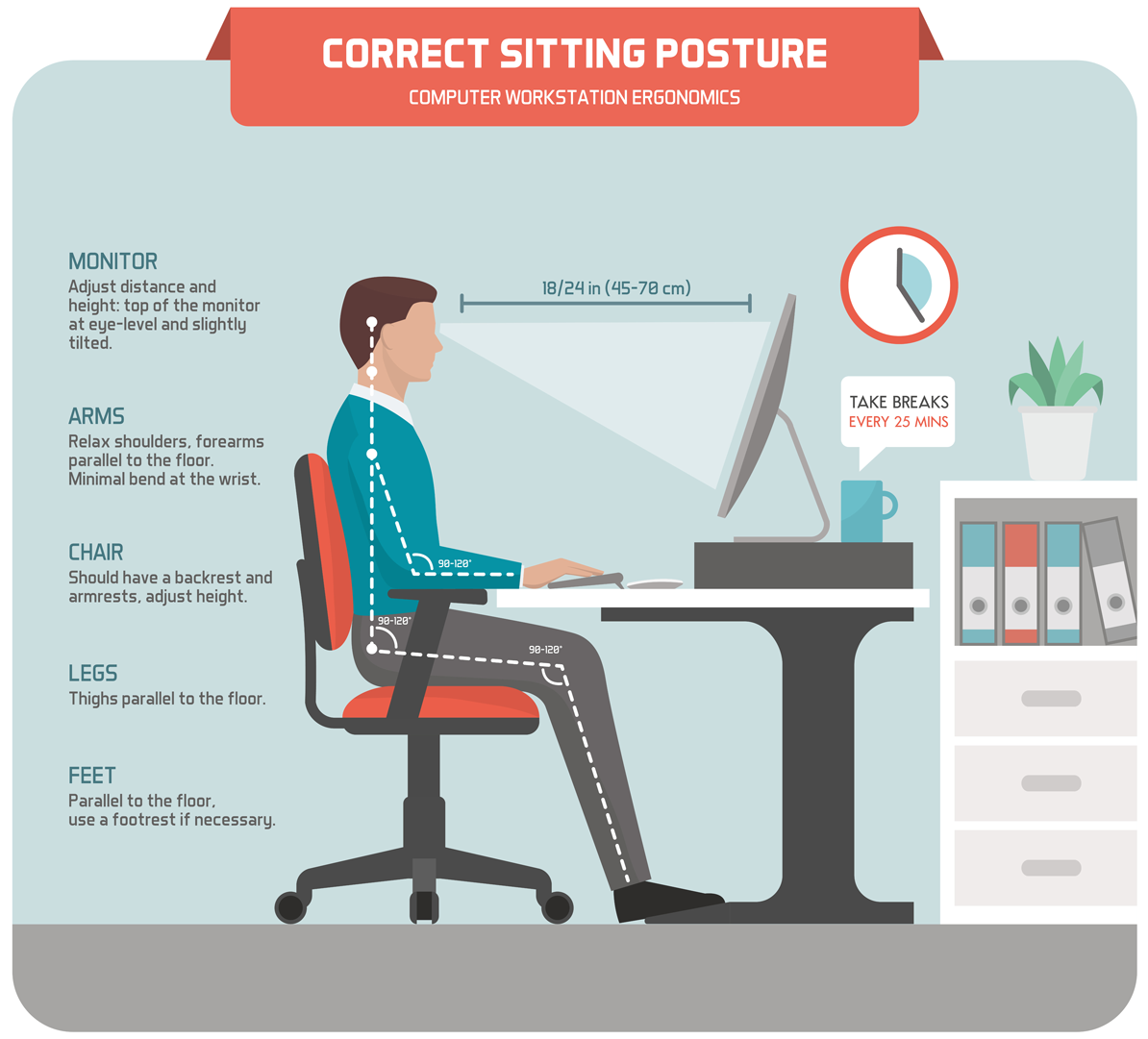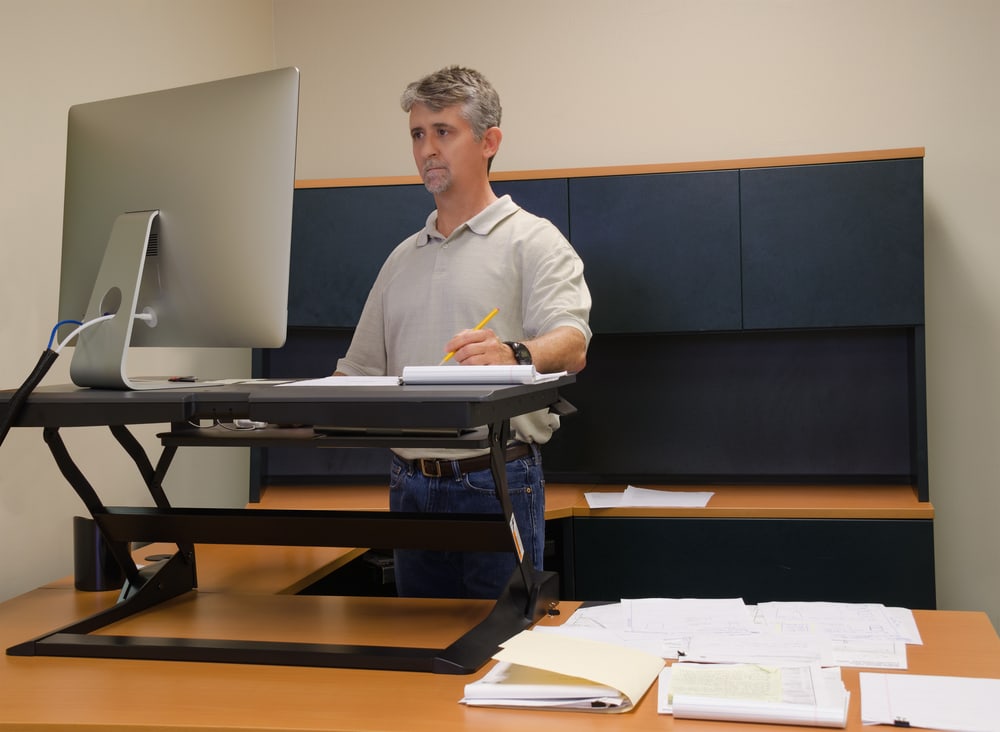
Warehouses are often considered dangerous workplaces– there are hazardous materials, vehicles, and hefty boxes to be carried. There is, however, one extremely dangerous workplace that is often forgotten: the modern office. Unlike warehouses, though, the hazards in offices are far less noticeable– and take more effort to prevent. As Long Island orthopedists, we’ll discuss how you can optimize your office life to limit back pain.
Office Life vs. Back Pain
For office workers, a sedentary lifestyle almost always leads to back pain. And, the spine is the most prominent source of occupation-related pain. Fortunately, there are ways that you can alter your work routine to prevent this pain.
#1 Reconfigure Your Desk
Sudden moves like twisting your arms or shoulder can echo throughout your body. For this reason, it’s important to be conscious of the location of various items on your desk in relation to other items.
- Keep your computer monitor(s) about 2-3 inches above eye level. This limits neck movement, and consequently neck strain.
- Situate your computer monitor(s) about an arm’s length away from your body.
- Place your keyboard within reach, so that you do not have to stretch your arms.
- Keep your mouse directly next to the keyboard, so that you can keep your hands and arms in a centralized position.
Curious about how you can further improve your desk configuration? Contact a Long Island orthopedist.
#2 Be Conscious of Your Posture
Unsurprisingly, your posture while working has a large impact on your spinal condition. This is especially true for an office environment, where posture often remains the same through many hours of repetitive sitting.
Adopting this posture will help your spine to remain healthy.
- Raise your head and neck above your shoulders without frequently looking down or straining forward.
- Use your diaphragm as the source of breath, not your mouth.
- Keep your feet planted on the ground, about shoulder width apart from each other. This prevents excess tension in the knees and ankles.
- Rather than slouching, keep your knees fixed directly above your ankles. In other words, keep your knees at a 90 degree angle.
- Avoid crossing your legs for extended periods of time, as this makes it difficult to maintain a straight spine, and interrupts blood flow.
- Select a chair that provides sufficient lumbar support for your lower back. Lean back ever so slightly to keep it reclined– but barely.

#3 Make an Effort to Alter Your Lifestyle
For some, the most hazardous office decisions lie in the lifestyle associated with the job. A lifestyle centered around productivity– adhering to deadlines, accepting phone calls at the most stressful moments– but it is far from ideal for your spine.
These are a few practices you can incorporate into your office lifestyle to put yourself at a lower risk for back pain.
- Take frequent breaks from sitting down to distance yourself from sources of stress, and more importantly, to reduce spinal disk pressure. This will also improve circulation.
- Don’t strain your eyes. Not only is this terrible for your vision, but also for your back. Leaning in to see the monitor is terrible for your spine, and could create a host of back problems. Instead, move the monitor closer to your body.
- Don’t hold the phone between your cheek and shoulder. This can cause quite the damage on your neck over time. Instead, use a headset or speaker to have private conversations.
For more insights about how you can reinvent your office lifestyle, speak to a Long Island orthopedist.
#4 Stretch Your Body
To keep your body limber and free from pain, there are plenty of exercises you can perform at work. These are some of the most popular (and beneficial) exercises you can perform from the comfort of your desk:
- Seat squeezes: squeeze your buttocks for 10 seconds. Repeat until your glutes are tired or you can’t continue. This exercise is great because it is extremely discreet.
- Seated leg lifts: While in a seated position, straighten one leg out in front of you and hold this pose for 5 seconds. Then, lower it down without touching the floor and repeat, alternating, for 15 reps each.
- Desk pushups: With your hands shoulder width apart on your desk and your legs behind you, push off with as much force as possible. Do this for 20 reps.
- Shoulder rolls: As you walk around the office, do mindless exercises like shoulder rolls. This will improve circulation and reduce pressure on the spine.
For more information about exercises you can do at work, check out our blog post. Or, speak to a Long Island orthopedist about which stretches will work for you
#5 Stand During Work
Standing at the office is becoming more and more popular each day. Many popular office furniture retailers offer standing desks, which enable workers to perform daily office tasks– type on the computer, speak on the phone, fill out paperwork– all while standing.
While the primary purpose of standing desks is to create conditions that are conducive to spinal health, there are myriad other health benefits. People who sit throughout the entire day are at a higher risk for diabetes and heart disease, and ultimately, an earlier death. This is largely because they are burning fewer calories, and consequently, gaining weight at a faster pace. Standing desks solve that problem by giving office workers a way to complete normal tasks in a more active stance. They are also reported to boost productivity.
5 Benefits of a standing desk
- Staying seated throughout the day can have a detrimental impact on your back. This sedentary position puts immense stress on the spine, shoulders, arms, and legs because the spine is tightened. Standing for at least a portion of the day will reduce this stress.
- Everyone knows by now that obesity, as well as conditions that accompany it, are linked to a sedentary lifestyle. By standing at work, you can burn calories with ease, preventing these conditions.
- Blood sugar levels generally rise after meals. One way to prevent this increase from impacting your health is activity following meals. So, standing after meals can prevent this increase in blood sugar, and also the development of type 2 diabetes.
- In addition to productivity, standing at work can also have a marked effect on energy and motivation throughout the office. In the same way that a sedentary lifestyle causes a greater risk of depression and anxiety, standing during work creates more opportunities for happiness and energy.
- As a result of the other health benefits, standing during work also increases life expectancy.

Before converting to a standing desk, though, it’s important to take note of how your body reacts to this change. Making this a transitionary phase and not a hardline shift will help you adjust to this lifestyle without bodily repercussions. Even after your body has grown adjusted to this lifestyle, standing throughout the entire day can be harmful. As Long Island orthopedists, we recommend striking a balance for maximum comfort.
#6 Communicate With Management
Oftentimes, management can be blissfully unaware of back problems around the office. You should not, however, suffer in silence. If your lower back pain becomes more intense due to long periods of sitting, then speak with your manager to arrive at a solution. They might be able to help you acquire new spine-conscious office equipment, or adjust your schedule/responsibilities to accommodate you.
Central Orthopedic Group – Long Island Orthopedist
As Long Island Orthopedists, we can help you to overcome back pain and transition into a more positive lifestyle. Our qualified and dedicated staff can help you strategize to overcome existing back pain and live a more spine-conscious lifestyle. Contact us for additional advice.
